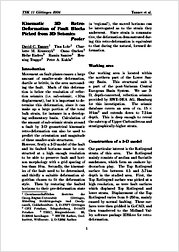Kinematic 3D Retro-Deformation of Fault Blocks Picked from 3D Seismics
Lohr, Tina
Endres, Heike
Samiee, Ramin
Trappe, Henning
Universitätsverlag Göttingen
Article in Anthology
Verlagsversion
Deutsch
Tanner, David C.; Lohr, Tina; Krawczyk, Charlotte M.; Oncken, Onno; Endres, Heike; Samiee, Ramin; Trappe, Henning; Kukla, Peter A., 2006: Kinematic 3D Retro-Deformation of Fault Blocks Picked from 3D Seismics. In: Philipp, S.; Leiss, B; Vollbrecht, A.; Tanner, D.; Gudmundsson, A. (eds.): 11. Symposium "Tektonik, Struktur- und Kristallingeologie"; 2006, Univ.-Verl. Göttingen, p. 226 - 228., , DOI: 10.23689/fidgeo-1823.
 |
View/
|
Movement on fault planes causes a large
amount of smaller-scale deformation,
ductile or brittle, in the area surrounding
the fault. Much of this deformation
is below the resolution of reflection
seismics (i.e. sub-seismic, <10m
displacement), but it is important to determine
this deformation, since it can
make up a large portion of the total bulk strain, for instance in a developing
sedimentary basin. Calculation of
the amount of sub-seismic strain around
a fault by 3-D geometrical kinematic
retro-deformation can also be used to
predict the orientation and magnitude
of these smaller-scale structures.
However, firstly a 3-D model of the fault
and its faulted horizons must be constructed
at a high enough resolution
to be able to preserve fault and horizon
morphology with a grid spacing of
less than 10 m. Secondly, the kinematics
of the fault need to be determined,
and thirdly a suitable deformation algorithm
chosen to fit the deformation
style. Then by restoring the faulted
horizons to their pre-deformation state
(a ‘regional’), the moved horizons can
be interrogated as to the strain they
underwent. Since strain is commutative,
the deformation demonstrated during
this retro-deformation is equivalent
to that during the natural, forward deformation...

